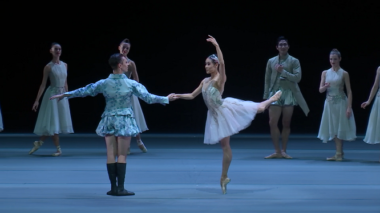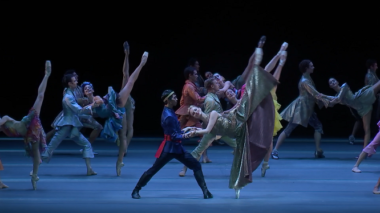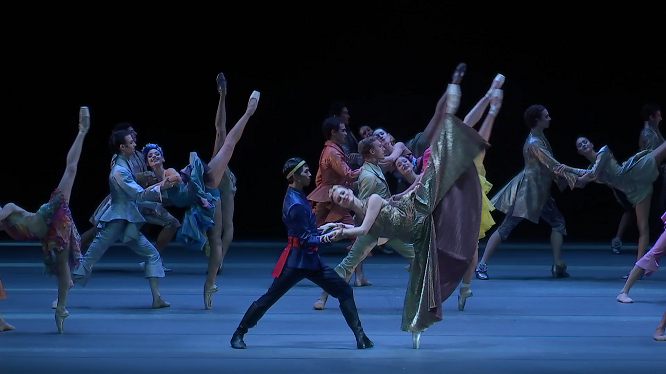 Austria Vienna State Ballet’s Sleeping Beauty (Dornröschen): Dancers of Vienna State Ballet, Orchestra of Vienna State Opera / Patrick Lange (conductor). Livestreamed (directed by Balázs Delbó) from the Vienna State Opera, 24.10.2022. (JPr)
Austria Vienna State Ballet’s Sleeping Beauty (Dornröschen): Dancers of Vienna State Ballet, Orchestra of Vienna State Opera / Patrick Lange (conductor). Livestreamed (directed by Balázs Delbó) from the Vienna State Opera, 24.10.2022. (JPr)

Production:
Music – Piotr Iylich Tchaikovsky and Giacinto Scelsi
Choreography – Martin Schläpfer and Marius Petipa
Stage designer – Florian Etti
Costume designer – Catherine Voeffray
Lighting and Video – Thomas Diek
Dramaturgy – Anne do Paço
Cast included:
The Queen – Olga Esina
The King – Masayu Kimoto
Princess Aurora – Hyo-Jung Kang
Prince Désiré – Brendan Saye
Catalabutte -Jackson Carroll
The Lilac Fairy – Ioanna Avraam
Carabosse – Claudine Schoch
The Blue Bird – Davide Dato
Princess Florine – Kiyoka Hashimoto
Faun – Daniel Vizcayo
The Forest Woman – Yuko Kato
I must admit how, for me, no production of Sleeping Beauty has surpassed that by Rudolf Nureyev for London Festival Ballet in 1975 and Martin Schläpfer is director of Vienna State Ballet and his reinterpretation of the fairy-tale ballet for the company will come fairly low on the list of the best versions I have seen. I appreciate it is 2020 and I have long advocated that classical ballet must respect its legacy while appearing to move forward and not become mummified. So in a sense I am arguing against myself but there is a familiar story to Sleeping Beauty everyone knows, and it should not just be turned into a series of dance set-pieces in need of a coherent storyline. Schläpfer has the 1890 original of Petipa and Tchaikovsky reoccur from time to time but with now most of the second act that would be mostly unrecognisable to them as it is to us who have seen the ballet multiple times.
The highlights are there including the entrance of Aurora and the Rose Adagio, the Blue Bird pas de deux, the cats duetting, as well as the wedding pas de deux (though with a twist). Something of Aurora’s awakening remains though prefaced by Giacinto Scelsi’s 1965 Anahit a rather tuneless piece for violin and orchestra (heard in a 1999 recording by Klangform Wien conducted by Hans Zender and played by Annette Bik). At this point we watch some of Schläpfer’s famed modern choreography in a trio for Prince Désiré who is led to the sleeping princess by a faun and a ‘Forest Woman’ who brandishes a violin. Research suggests that ‘Anahit was the goddess of fertility and healing, wisdom and water in Armenian mythology’ though what this has to do with Sleeping Beauty only Schläpfer could explain.
There is not much to describe in the way of sets (from stage designer Florian Etti) and no recurrent stage furniture other than some chairs. The Prologue is fairly dark, but we see the silhouettes of thorny roses at the back and again during the first act, then there is something of a woodland glade in Act II and for the wedding a tree canopy is visible through some slit-like wall openings. Catherine Voeffray’s vibrantly coloured costumes veer from something worn at an haute couture fashion show or posh cocktail party to possibly a carnival.
As the music begins, we see the King (Masayu Kimoto) and Queen (Olga Esina) praying for a child and soon master of ceremonies Catalabutte (colourfully costumed and equally extravagantly danced by Jackson Carroll) is welcoming guests to the christening of Princess Aurora. Here the significance of the gift-bringing fairies (Sinthia Liz, Alexandra Inculet, Anita Manolova and Alaia Roger-Maman) is much diminished with Aurora in her crib up high above the stage like a chandelier. Catalabutte is distraught when he realises he has left the evil fairy, Carabosse, off the guest list. When she comes in with her two henchmen she uses the traditional mime to curse Aurora. On her sixteenth birthday she will prick her finger on a spindle and die, though this is commuted by the Lilac Fairy into a sleep of a hundred years until awoken by a prince.
We reach that fateful day in Act I and it appears one of the attendants has an outlawed spindle, but her life is spared when Catalabutte pleads on her behalf. Aurora is introduced to her four suitors and she dances with the princes who also dance on their own. The disguised Carabosse arrives and Aurora’s finger gets pricked with the spindle she proffers. Aurora’s death throes are rather Giselle-like until she collapses in the king’s arms. The Lilac Fairy confirms she is merely sleeping before she confronts Carabosse and they circle each other.
After the excursion into Scelsi in Act II, the more familiar music returns when the prince kisses Aurora and she wakes up. The court are revived too and Catalabutte, the king and queen enter and bless the marriage of Prince Désiré and Aurora as Carabosse (the dramatic Claudine Schoch) begs forgiveness for her wrongdoing. For the final act those attending the wedding are welcomed by Catalabutte and will remain on the fringes of the stage unless they are dancing in various combinations. A feature of this Sleeping Beauty is how much dancing the king and queen do and there is a trio at this point with the Lilac Fairy (the refined Ioanna Avraam). There is a duet of feline grace from the cats (Eszter Ledán and Marian Furnica) and a pas de deux for the Blue Bird and Princess Florine – from a seriously-underpowered and oddly bare-chested Davide Dato and a charmingly fluttery Kiyoka Hashimoto – which lacked any ‘Wow!’ factor. The Faun (Daniel Vizcayo) and Forest Woman (Yuko Kato) reappear with some floor spinning and Vizcayo walking on his knees at one point for little reason as far as I could see.
The prince (in rather inelegant frilly white shirt and blue trousers) brings Carabosse back into the fold and soon there a lot of waltzing by all concerned as the wedding celebrations begin in earnest. Wearing an exquisite white wedding dress Hyo-Jung Kang was at her best in the pas de deux with her charming variation of gossamer lightness. I was unimpressed throughout this Sleeping Beauty by Brendan Saye’s tall and stiff-backed prince, and he was outdanced by Kimoto’s king as Schläpfer has them share the famous solo. The choreographer adds an epilogue beginning with another solo for the king before, together with the queen, they greet Prince Désiré and Aurora and relinquish their crowns to them. The queen (the always regal Esina) doesn’t seem too happy about that and the ballet ends with the court bourréeing and receding to the back leaving the Forest Woman to stand guard over the king and queen who have lain down on the floor.

Schläpfer’s choreographic language is rather restricted and angular, there are lots of straight arms pointing upwards, splayed and extended legs, and regimented ensemble dancing in straight lines facing forward. Sadly, the company were occasionally ill-at-ease on the opening night and things might improve later in the run of performances. (The closeup camerawork was unforgiving highlighting a major misstep by one of the leading dancers and another who briefly hit the floor.) There cannot be a finer orchestra than that of Vienna State Opera (members of the Vienna Philharmonic) to play Tchaikovsky’s glorious score and glorious it sounded through my loudspeakers; though it looked like Patrick Lange’s swift tempi challenged some of the dancers on occasions.
Sleeping Beauty doesn’t seem that popular in Vienna with the archive suggesting less than 150 performances before this new production which succeeds ones by Reinhard Schwarz, Rudolf Nureyev and Sir Peter Wright. How long Schläpfer’s will last only time will tell.
Jim Pritchard

Agree 💯